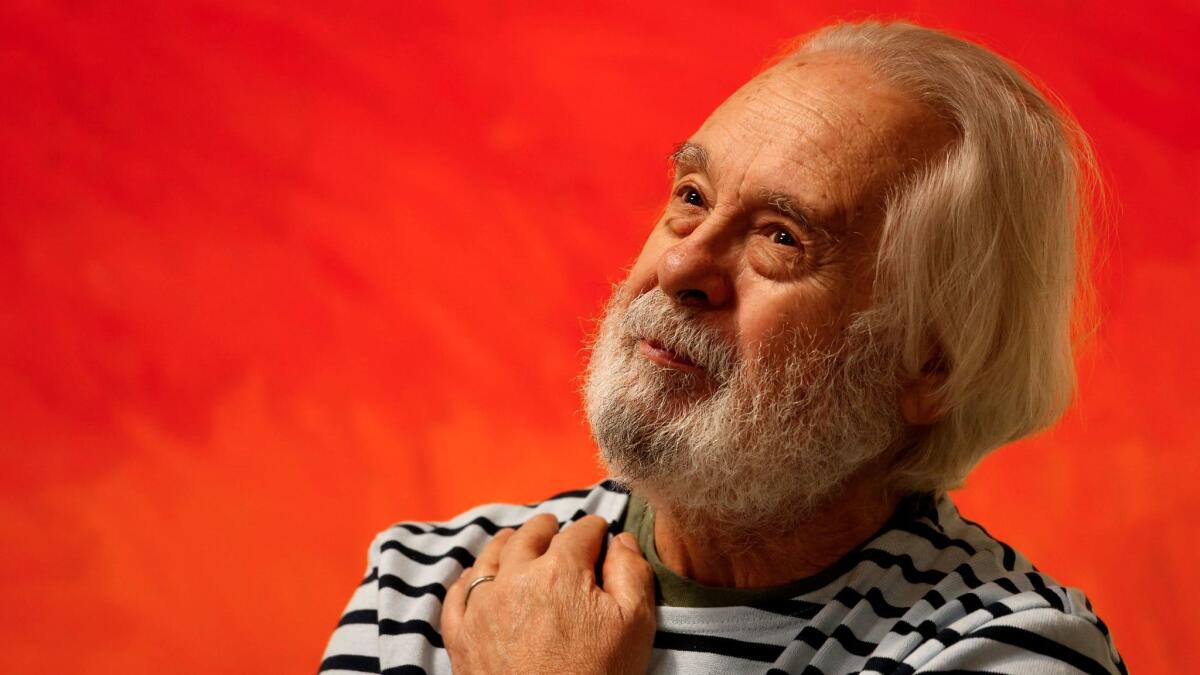Our primer for Spring Arts activities highlights events in art, books, dance, theater, classical and pop music, as compiled by Los Angeles Times critics and writers. Posthumous duets, responses to Trump and spotlights on Iceland, Pasadena and Coachella are among the offerings.
- Share via
Review: The best of Coachella Valley’s new ‘Desert X’ art installations
In January, prosecutors in Riverside filed 30 felony charges against two longtime Palm Springs developers and a former mayor in an alleged $375,000 bribery scheme related to building projects downtown.
Ah, the romance of the desert! A place of fierce natural beauty and beguiling spiritual wonder! A rejuvenating refuge from the crushing pressures of modern urban life!
“Desert X,” the ambitious exhibition of new site-specific art installations scattered around the Coachella Valley, is successful partly because the 16 participating artists mostly skirt romanticized desert clichés — or else they engage them, casting a skeptical or parodic eye. Perhaps surprisingly, none chose to consider the springs that made this corner of the desert bloom; but many works burrow into the area’s complex history and heterogeneous present.
- Share via
Mayor Eric Garcetti has a chance to shape the civic landscape more profoundly than any mayor since Tom Bradley

In 2009, Los Angeles magazine put a picture of Antonio Villaraigosa, newly elected to a second term as mayor, on its cover beneath a blaring single-word headline: “Failure.”
His successor, Eric Garcetti, who is on the verge of his own second term, has never faced that kind of hostility from the media. Yet neither has he whipped up a great deal of excitement. Widely but not wildly popular, Garcetti, 46, has largely packaged himself as a back-to-basics mayor, a persona that tends (by design, presumably) to keep his political instincts and sizable ambition tucked away from public view.
That’s not to say that Garcetti doesn’t have an opportunity to put a major imprint on the city. This is especially true when it comes to the subjects central to this column, including civic architecture, urban planning and the design of public and green space across Los Angeles.
- Share via
Margaret Atwood brings back ‘Angel Catbird’ and looks ahead to ‘The Handmaid’s Tale’
From her perch in Toronto, Canada, author Margaret Atwood has been observing the current American political landscape with a cat’s watchful eye. Along with George Orwell’s “1984,” Atwood’s 1985 dystopian novel “The Handmaid’s Tale” recently returned to the Amazon best-seller lists. The Hulu TV version of the novel, premiering in April, has no doubt spurred interest, but it’s also a response to Donald Trump’s America, where Gilead, Atwood’s imagined theocracy in which women are forced into bearing children, seems more possible than ever.
We’re talking today about her graphic novel series, “Angel Catbird,” which debuted in 2016 to sparkling acclaim. Volume 2 arrived on Valentine’s Day, and Volume 3 comes out in July. Since she’s cranking out sequels, it’s too tempting to ask: Is she thinking of a follow-up to “The Handmaid’s Tale”?
- Share via
California African American Museum exhibition shows the 1992 L.A. riots were about more than Rodney King
On April 29, 1992, the city of Los Angeles exploded in violence after a predominantly white jury acquitted four Los Angeles police officers in the videotaped beating of motorist Rodney King. By the time it was over six days later, more than 50 people lay dead and 600 buildings were destroyed.
“No Justice, No Peace: LA 1992,” a new exhibition at the California African American Museum, revisits the events on the 25th anniversary of the Los Angeles riots. But it isn’t a simple rehash of images of burned buildings and National Guardsmen in the streets.
Instead, through more than 250 images and objects — including a 1940s zoot suit and a ’90s-era police cruiser — the show digs deep, looking at the long history of policing and minority communities in Los Angeles, as well as housing segregation, the drug war and other social and political forces that made the uprising so explosive. “It’s common for people to think of 1992 as a reaction to the Rodney King verdict,” says exhibition curator Tyree Boyd-Pates. “It was much more than that.”
- Share via
L.A. Phil’s festival highlights amazing music from an unlikely place: Iceland
The cataclysmic financial meltdown that decimated the Icelandic króna in 2008 did nothing to dampen the rich musical culture that had been blossoming in the remote Nordic island for decades. But now the country with a population of a little more than 300,000 boasts such a thriving music and arts scene that the Los Angeles Philharmonic is hosting the 17-day Reykjavík Festival at Walt Disney Concert Hall, beginning April 1.
The festival, curated by Icelandic composer and conductor Daníel Bjarnason and L.A. Phil conductor laureate Esa-Pekka Salonen, features an eclectic mix of classical, contemporary, choral, chamber, symphonic, pop, experimental and electronic music, including a three-night stand by the influential post-rock band Sigur Rós accompanied by the L.A. Phil. The festival will showcase the work of 50 composers and more than 60 musicians and artists, with 18 world premieres, three art installations and more than 24 hours of music.
For a few days in April, L.A. is going to have in its midst some of the most interesting artists in Iceland — not just some, but an impressive collection of them.
— Chad Smith, L.A. Phil chief operating officer
Björk will make her Disney Hall debut May 30 in what the L.A. Phil is calling a special extension to the Reykjavík Festival. She will perform with an orchestra, timed with the “Björk Digital” exhibition at the Magic Box at the Reef opening May 19.
- Share via
Chicano art pioneer Frank Romero still paints, still loves cars and still defends ugly palm trees

Frank Romero is known for capturing expressive scenes of Southern California in his paintings: Looping freeways, historic architecture and streams of automobiles — the latter most famously rendered in a mural on the 101 Freeway in downtown L.A. He is the subject of a sprawling spring retrospective at the Museum of Latin American Art in Long Beach.
“Dreamland,” as the show is called, brings together more than 200 works from throughout his career — including the socially and politically minded works for which he is renowned. Among these is the 1996 canvas “The Arrest of the Paleteros,” which was inspired by police crackdowns on street vending and now belongs to actor and comedian Cheech Marin, a collector of Chicano art.
I don’t know how to do anything else. I’ve done it all my life.
— Frank Romero on his life as a painter
In this edited conversation, Romero talks about how film influenced his career, how he ended up working as a graphic designer in the studio of Charles and Ray Eames, and how he got caught up in the cultural revolutions of the 1960s and ’70s.
- Share via
How a Pasadena theater troupe builds a future on the past
Waring grimy boxers and a bowler festooned with foliage, gray-bearded Geoff Elliott prances onstage, portraying King Lear in a scene in which Shakespeare’s mad monarch grows even madder. The once-mighty patriarch rants and cries as he wanders the countryside in his underwear.
“It’s a mountain of a role,” Elliott says later, “one I’ve waited 30 years to play, until I had the life experience for the part.”
Aging, it seems, has its rewards — an idea the 58-year-old performer can appreciate as an artist and as a co-founder of A Noise Within. As it celebrates its 25th-anniversary season, the Pasadena-based troupe is doing some of its best work ever, he says, after “a long journey in which we built a company, a community and, at long last, a theater.”
- Share via
Aimee Mann embraces the darkness on ‘Mental Illness,’ her first album in five years

If an album with the title “Mental Illness” suggests messy thoughts, the reality is similarly misleading. Aimee Mann’s ninth solo studio album, which comes out March 31, is an exercise in restraint, relying on understated guitar, a touch of bass and drums and sparse string arrangements composed by her longtime producer, Paul Bryan.
Filled with lyrics that highlight tormented characters, the 11 songs on “Mental Illness” are the most recent by an artist best known for her Grammy-nominated work on the score to Paul Thomas Anderson’s film “Magnolia.”
On that score and across her acclaimed body of work, Mann’s empathy as a songwriter has resulted in her lyrics being painted as depressing.
This is a lyricist, after all, who indicted optimists in the title to her album “@#%&*! Smilers,” and dumb people in an earlier one, “I’m With Stupid.” And though Mann is friendly and has a dry, sarcastic demeanor, her role as a nihilist in “The Big Lebowski” seems a bit of typecasting.
“Mental Illness,” she says, was composed as a response to that perceived nihilism.
The fact that it’s thematically about people who are obsessed — who won’t let go after things aren’t working — strikes a chord.
— Aimee Mann
- Share via
The Times’ guide to what to do, see and listen to this spring and beyond

Los Angeles Times critics and writers guide you through the season in art, books, dance, theater, classical and pop music.